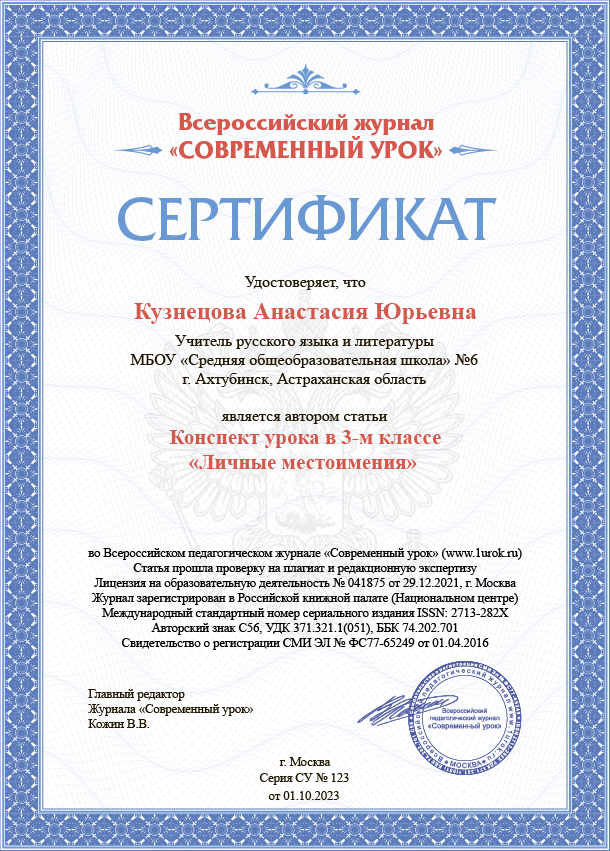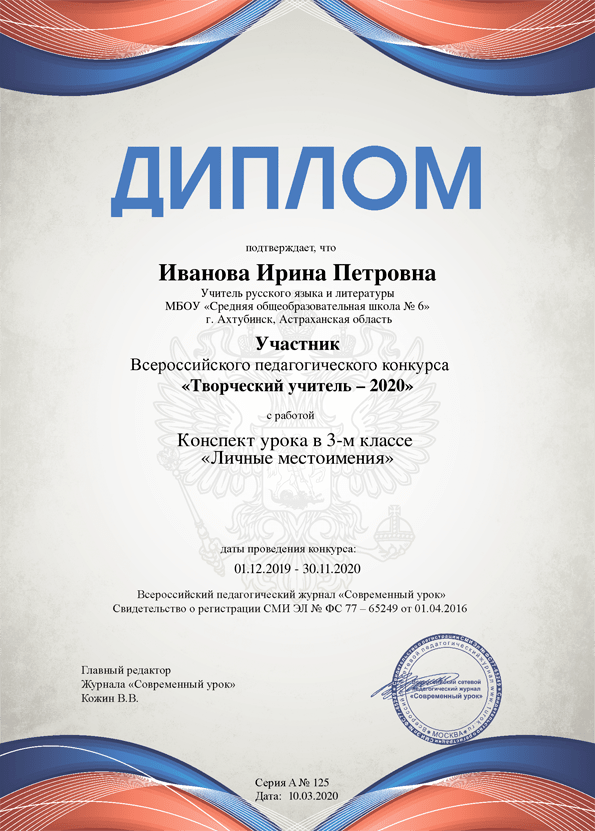Межличностные отношения. Обязанности и права человека в обществе
Автор: Дениев Хусейн Кюриевич
Организация: ГБОУ СОШ №9
Населенный пункт: Чеченская Республика, г.Аргун
Класс: 11
Тема: Межличностные отношения. Обязанности и права человека в обществе
Тип урока: Комбинированный урок
Цель урока: Развитие навыков говорения и аудирования по теме "Межличностные отношения и разрешение конфликтов", расширение словарного запаса и совершенствование грамматических навыков в контексте темы.
Планируемые результаты:
Личностные: Формирование навыков конструктивного разрешения конфликтов; развитие эмпатии и толерантности в межличностных отношениях.
Предметные: Расширение лексического запаса по теме "Конфликты и их разрешение"; совершенствование навыков использования условных предложений для обсуждения гипотетических конфликтных ситуаций; развитие умений монологической и диалогической речи по теме урока.
Метапредметные: Развитие умения анализировать конфликтные ситуации и находить пути их решения; формирование навыков критического мышления и эффективной коммуникации.
Ключевые слова: CONFLICT RESOLUTION, COMMUNICATION, COMPROMISE, MEDIATION, ACTIVE LISTENING
Оборудование и материалы: Компьютер с проектором, интерактивная доска, раздаточные материалы, доступ к интернету для использования электронных образовательных материалов.
Блочно-модульное описание урока
БЛОК 1. Вхождение в тему урока и создание условий для осознанного восприятия нового материала
1. Мотивирование на учебную деятельность
Учитель: Good morning, class! Today we're going to explore an important aspect of interpersonal relationships - dealing with conflicts and finding ways to resolve them. Let's start by looking at some images depicting various conflict situations.
- показывает галерею изображений конфликтных ситуаций)
Учитель: What do you notice about these images? How do they represent different types of conflicts?
2. Актуализация опорных знаний
Учитель: Let's review some vocabulary related to our topic. Match the words with their definitions:
- Conflict
- Compromise
- Mediation
- Resolution
- Negotiate
a) The action of solving a problem or dispute b) A disagreement or argument c) To discuss something in order to reach an agreement d) An agreement reached by each side making concessions e) Intervention in a dispute to resolve it
3. Целеполагание
Учитель: Based on our discussion and vocabulary review, what do you think our goals for today's lesson might be?
Ожидаемые ответы учеников: Learn about conflict resolution, practice discussing conflict situations, improve our communication skills in difficult situations.
Учитель: Excellent suggestions! Today we will expand our vocabulary related to conflict resolution, learn strategies for preventing and resolving conflicts, and practice using conditional sentences to discuss hypothetical conflict situations.
БЛОК 2. Освоение нового материала
1. Осуществление учебных действий по освоению нового материала
Учитель: Let's learn some new phrases related to conflict resolution.
Учитель представляет новую лексику
- to diffuse tension - разрядить обстановку
- to see eye to eye - сойтись во мнениях
- to meet halfway - пойти на взаимные уступки
- to clear the air - прояснить ситуацию
- to agree to disagree - согласиться на разногласия
- to extend an olive branch - предложить примирение
Грамматический материал: When discussing hypothetical conflict situations, we often use conditional sentences, particularly the second conditional. Let's review its structure:
"If + Past Simple, would + infinitive"
For example: "If I were in your situation, I would try to talk it out calmly."
2. Проверка первичного закрепления
Учитель: Let's practice using our new vocabulary and grammar. Complete the following sentences:
- If they _____ (have) better communication skills, they _____ (avoid) many conflicts.
- We should try to _____ (meet halfway) to resolve this issue.
- If I _____ (be) you, I _____ (extend an olive branch) to mend the relationship.
БЛОК 3. Применение изученного материала
1. Применение знаний, в том числе в новых ситуациях
Учитель: Now, let's analyze a case study about a conflict in a workplace setting.
Учитель: Let's analyze the following case study about a conflict in a workplace setting:
Case Study: Conflict in the Marketing Department
Sarah and John are colleagues in the marketing department of a large company. They have been assigned to work together on a crucial project for a new product launch. However, tensions have been rising between them due to their different working styles and approaches to the project.
Sarah is very detail-oriented and likes to plan everything meticulously. She believes in following a strict timeline and wants to stick to traditional marketing strategies that have worked well in the past. John, on the other hand, is more creative and spontaneous. He wants to try new, innovative marketing techniques and believes that flexibility is key to success in today's fast-paced market.
Their disagreements have led to missed deadlines and a lack of cohesion in their marketing strategy. The project is falling behind schedule, and their manager has noticed the tension between them. Other team members are feeling uncomfortable and unsure about the direction of the project.
Recently, during a team meeting, Sarah and John had a heated argument about the direction of the campaign, which ended with John storming out of the room and Sarah refusing to compromise on her ideas.
Задание: Read the case study and discuss with a partner:
- What are the root causes of the conflict between Sarah and John?
- How could Sarah and John have prevented this conflict from escalating?
- What steps would you suggest to resolve the situation and get the project back on track?
- How might their manager intervene to help resolve this conflict?
Задание: Read the case study and discuss with a partner:
- What are the root causes of the conflict?
- How could the parties involved prevent this conflict?
- What steps would you suggest to resolve the situation?
2. Выполнение межпредметных заданий из реальной жизни
Учитель: In groups of three, role-play a conflict situation and its resolution. Use the new vocabulary and conditional sentences we've learned. The rest of the class will provide feedback on your conflict resolution strategies.
3. Систематизация знаний и умений
Учитель: Let's create a mind map on the board summarizing the key strategies for conflict prevention and resolution we've discussed today.
БЛОК 4. Проверка приобретенных знаний, умений и навыков
1. Диагностика или самодиагностика
Учитель: Let's check our understanding with a quick quiz:
- Which phrase means to calm a tense situation? a) To see eye to eye b) To diffuse tension c) To meet halfway d) To clear the air
- What type of conditional is used in the sentence "If I were you, I would apologize"? a) Zero conditional b) First conditional c) Second conditional d) Third conditional
- Which of the following is NOT a typical step in conflict resolution? a) Active listening b) Compromising c) Ignoring the problem d) Finding common ground
- What does "to extend an olive branch" mean? a) To start a fight b) To offer peace or reconciliation c) To win an argument d) To avoid responsibility
- Which phrase means to partially agree with someone? a) To clear the air b) To see eye to eye c) To meet halfway d) To agree to disagree
БЛОК 5. Подведение итогов, домашнее задание
1. Рефлексия
Учитель: Let's reflect on what we've learned today using this checklist. Think about how your understanding of conflict resolution has changed.
(Учитель демонстрирует чек-лист на интерактивной доске)
2. Домашнее задание
Учитель: For homework, please do the following:
- Write an essay (200-250 words) about a conflict you've experienced or witnessed, and how it was resolved (or could have been resolved better). Use at least 5 new vocabulary words we learned today and include 3 conditional sentences.
- Create a "Conflict Resolution Guide" for your peers, outlining steps to prevent and resolve conflicts. Include examples and explanations.








